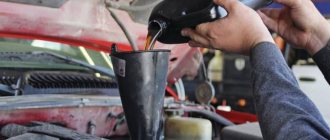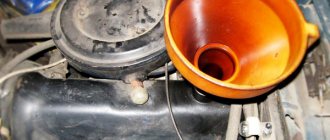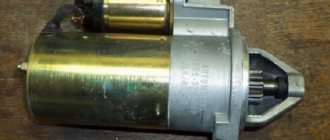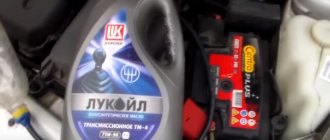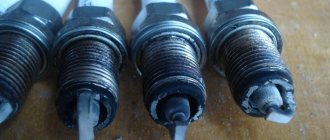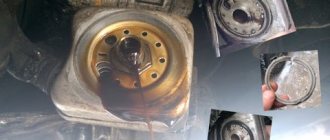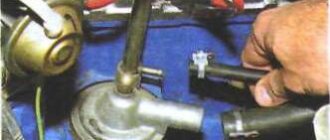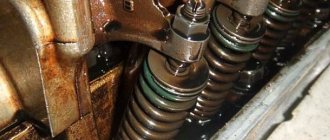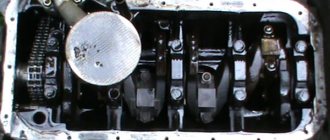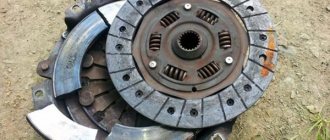Owners of Lada Priora cars often experience increased oil consumption. The role of motor oils in engine operation is very important. One of the main tasks is the formation of a film with low friction coefficients on the surfaces of rubbing surfaces. Lubricating fluids also cool the elements of the piston group and timing mechanism. Oil transports carbon deposits and metal particles to the filter. Many owners would like to know why the Priora consumes oil. Let's look at why this happens and how to fix it.
What is increased consumption
By the term “eating oil”, car owners mean increased consumption of lubricating motor fluids.
Often, during normal operation, such waste should not occur - the standards established by the manufacturer will be observed if there are no problems. If the technical documentation for the car states that replacement should be carried out once every 10 thousand kilometers, and the driver has to top it up more often, then this is an increased consumption.
Purpose of motor oil
The operating manual of any machine contains information about oil consumption. Lubricating fluid allows all car components to operate fully and efficiently. When driving, many interconnected processes take place in the engine.
Friction appears between contacting parts, which has a destructive effect on motor parts. Motor oil reduces the negative effects of friction and wear of spare parts.
With increased Priora oil consumption, the contacting parts are not able to properly perform their task. They are subject to abrasion, the engine jams and breaks. In order for the machine to operate continuously and for a long time, it is necessary to control the volume of oil fluid.
Where does it go?
The correct operation of internal combustion engines largely depends on whether there is a sufficient amount of lubricants inside. Oil, as noted above, is necessary to reduce friction between the rubbing surfaces of parts. The most intense friction is in the parts of the cylinder-piston group. Since high temperatures are constantly maintained in the engine, some of the oil burns out in the cylinders and is then removed along with the exhaust gases. Also, part of the lubricating fluid settles on the cylinder walls, on valve seats, and on oil scraper piston rings.
Increased consumption, complaints from drivers that the Priora is consuming oil - this is a sign that the engine has one or more malfunctions. Most often, the reason is very banal - it is natural wear and tear of the CPG. The first call is oil in the crankcase ventilation system. This happens due to high gas pressure in the crankcase. This pressure will increase as the engine wears out.
Why is lubricant quickly used up?
"Priora", despite its modern engine, "eats" a lot of oil. The reasons for this are as follows:
Often, car oil leaks occur due to poor crankcase ventilation. This happens because the exhaust enters the crankcase through the piston rings. Gases create increased compression, which disrupts the normal flow of processes in the unit. The oil is simply squeezed out of the engine.
Why do Priors eat oil, besides the reasons listed above? Oil is probably leaking from the valve plug or oil filter. To eliminate such leaks, the lining must be replaced. Constant vibration exposure, high loads, trips over rough terrain - all this causes various leaks.
Synthetics have good viscosity characteristics, ensuring the uninterrupted functioning of all units. It contains many additives that soften and partially eliminate the consequences of the negative impact on the power unit.
Mineral water does not have the advantages of synthetics. It pollutes the lubricating complex with its own combustion products. As a result, it turns out that the car “eats” oil.
An excessive operating period may also be the reason that the machine eats oil. Since the characteristics of the motor oil deteriorate during operation, some of the lubricant evaporates and burns out.
This negatively affects the car engine. Timely measures taken will allow the power unit to operate without failures for a long time.
Oil consumption rates for Lada Priora
The car can be equipped with one of four engines. Each modification has its own expense. Thus, an 8-valve 1.6-liter engine with a power of 87 horsepower should consume up to 50 grams per thousand kilometers according to standards. The VAZ-21126 model with a power of 98 horsepower should also, according to the manufacturer, have modest appetites. The 1.8 liter model (VAZ-211128) has an oil consumption rate of 300 grams per thousand kilometers.
For 1.6 units, the oil consumption rate does not exceed 50 grams. The latest engine is modernized. Its key features are that with a standard cylinder block, the developers changed the stroke of the pistons by using a different crankshaft and shorter connecting rods. This technical solution led to increased loads on the engine, or more precisely on the pistons, rings, cylinder block walls and connecting rods.
In some cases, if the engine is severely worn out, the Priora consumes up to 3 liters of oil per thousand kilometers. Let's look at the main reasons for increased oil appetite in a car.
We fix problems
If you notice that the engine is eating oil, and the reasons for this are wear of valve stem seals, rings, structural gaskets or abrasion of the walls of the cylinder block, then immediate replacement of these elements is required. Timely car maintenance will allow you not only to save money by preventing serious major repairs, but also to diagnose other possible problems with the engine system or the car as a whole in the early stages.
When selecting the right automotive lubricant, always rely on the manufacturer’s recommendations. Under no circumstances should you pour liquid under the hood whose viscosity prohibits the use of the car manual.
In addition, if you want to achieve economical fuel consumption, avoid sudden starts and braking. Of course, the instantly increasing power of the engine increases adrenaline in the driver’s blood, but in the car it causes overheating and active consumption of technical fluids. If you cannot give up extreme driving, then do not be surprised that oil consumption will be many times higher than the standards established by the manufacturer.
Reasons for increased consumption
Several can be highlighted. The most common is wear of the valve stem seals. They are installed in the gas distribution mechanism.
Problems with caps should be solved very carefully, despite their simplicity. So, these elements are made of rubber - it can harden. This probability increases significantly if the engine does not warm up well. “Priors” with high mileage often suffer from this. The cuff (if it is frozen) will not be able to fit tightly into its seat - because of this, the oil will enter the valve sleeve without any obstacles. As a result, the lubricant will enter the cylinders, where it will burn safely. Oil can also get into the exhaust system. There will be characteristic blue smoke.
Rings
The Priora consumes oil not only because of the caps. The second most common problem is the piston rings. Each of the pistons, and there are four of them in a car engine, has three rings. Two of them are compression, and the third (lowest) is an oil scraper.
Automakers use compression rings to reduce the distance between the piston and cylinder. This ensures maximum energy transfer. To reduce friction, compression rings are lubricated. This oil should then be removed by the oil scraper ring. If the latter is worn out, then it is not surprising that the Lada Priora is burning oil.
If the ring is worn, it will not be able to remove oil from the cylinder walls. As a result, the lubricant will enter the combustion chambers, where it also burns safely.
The car constantly heats up/cools down over its entire service life. Naturally, huge loads fall on every component and part in the engine. If the elasticity or wear of the piston rings has decreased, then this may be the cause of an interesting phenomenon - flutter. Little is known about it yet; this phenomenon has not yet been well studied. But during engine operation, the rings rotate around the piston at certain speeds. In doing so, they can even jump from one edge of the piston groove to the other. In fact, this reason is revealed even more often than ring wear when there are complaints that the Priora burns oil but does not smoke. Although a clear sign of increased oil consumption is blue smoke from the exhaust pipe.
Allowable flow
You can say that a car consumes oil in excess of the norm if the consumption of the lubricant mixture does not correspond to the volume specified by the manufacturer. This parameter is determined by the engine size (depending on the number of pistons in the power unit). Table 1 illustrates the approximate oil consumption for waste with a working engine, taking into account the use of high-quality lubricant.
Table 1. The volume of motor fluid lost to waste after 8-10 thousand vehicle mileage*.
| Engine volume, l. | Amount of oil for waste, ml. |
| 1-1,6 | 150-200 |
| 1,8-2,5 | 180-250 |
| 2,5-3,5 | 200-300 |
*The table shows average values, see the operating instructions for your car for exact figures. For some models, the consumption rate will be several times higher.
If your car consumes more engine mixture than the amount indicated in Table 1, then you need to find out where the oil goes.
Motorists often ask: “Why does the engine burn oil but not smoke?” This phenomenon is quite strange - smoke is one of the criteria confirming excessive consumption of motor fluid. If the driver claims: the car eats a lot of oil, but does not smoke, then he is mistaken - the characteristic blue smoke appears only when the engine is loaded, while it completely disappears in neutral or park gear. Ask someone to drive your car and you will see that when accelerating or changing gears, the vehicle smokes - oil gets into the combustion chamber of the engine. We will give below the most common reasons why a car eats engine oil and, according to the owner, does not smoke at all.
You can also see why the engine overuses oil and does not smoke in the video:
Low quality oils
One of the reasons for increased consumption is the low quality of this same oil or the wrong choice. For each engine, including the Lada Priora, there are certain tolerances. But if you make the wrong choice, your consumption can skyrocket. For example, reduced viscosity can cause the rings to fail and collect lubricant from the cylinder walls. Therefore, the lubricant will settle on the walls of the combustion chamber and, as a result, will burn along with the fuel.
As a result, exhaust gases will come out in the form of bluish smoke, and the oil will settle as soot on the spark plugs. For the same reason, the rings become coked. Oil settles in a very thick layer on engine parts and components.
The engine oil consumption is increased, but the engine does not smoke: the main reasons
To understand why the engine eats oil but does not smoke, you need to study the possible causes of increased lubricant consumption.
First of all, if there is no oil smoke, but oil consumption is higher than normal, at first glance it may seem that there are no problems with the cylinder-piston group.
As a rule, drivers often attribute increased lubricant consumption without obvious engine smoking to poor oil quality. Some people also tend to believe that after driving at high speeds, an increase in consumption is completely normal.
Let us immediately note that in both the first and second cases certain losses are allowed, but if you have to add oil in liters every 2-3 thousand km. mileage, then it has nothing to do with the quality of the lubricant and the operating characteristics of the car.
- In other words, there are problems that need to be fixed. Most often, the main cause is an oil leak. At the same time, there is not always an obvious leak, when after parking you can notice drops of lubricant under the car. For this reason, when parking, you need to place a sheet of white cardboard under the car.
- In this case, a leak cannot be ruled out either, but determining the location of the leak will be even more difficult. So, whether there are stains under the car or not, we move on to the next stage, which involves a visual inspection of the engine compartment and engine compartment.
You should immediately inspect the valve cover gasket, as this problem is very common. If oil leaks are visible on the outside of the engine, then the problem is obvious. The solution is to replace the valve cover gasket or install fresh valve cover sealant.
- The next element to check are the seals. Both the front and rear crankshaft oil seals can leak. Camshaft seals also often leak.
At the same time, the condition of the seals itself is difficult to determine during external examination. A sure sign of an oil leak is “fogging” of the oil seals, heavy oiling at the place of their installation, etc. At the same time, it is necessary to change the engine seals faster. The fact is that in addition to loss of lubricant, oil can get on other parts and components.
- Often grease leaks from under the oil pressure sensor. In this case, the problem is usually not solved by simply tightening the sensor; the leak is eliminated by replacing the device. Also, lubricant leakage may be due to the fact that the oil filter is of poor quality or installed incorrectly.
By the way, on many internal combustion engines the oil pressure sensor is located above the oil filter. Visually, a sensor leak can be mistaken for leaks from under the oil filter housing, but replacing the oil filter with a new one does nothing. For this reason, before deciding to replace the filter, you need to make sure that the sensor is working properly.
- The camshaft plug, which can be found on engines with two camshafts or internal combustion engines with a single camshaft that do not have a distributor, deserves special attention during diagnostics.
The only thing is that if the plastic plug can be changed quickly and easily, then the rubber plug requires more precise installation in place in order to get rid of leaks and achieve the desired tightness.
- If the engine is equipped with a distributor, oil may leak through the O-ring. Replacing such a ring is not difficult, but then you will need to set the OZ.
A more difficult case is when oil gets into the distributor. The main symptom is a characteristic cracking sound (bearing cracks), as well as malfunctions of the distributor. In this case, the distributor will require disassembly, cleaning and replacement of the bearing along with the oil seal.
Natural wear and tear
If the Priora engine consumes oil, then most likely the engine has a high mileage, and the reason for oil consumption is the natural wear and tear of the engine itself and its individual components. As a result, oil will be consumed much faster than during normal operation. Engine wear can also be the cause of cylinder deformation, cracks, gasket burnout, and failure of engine seals. Motor oils can be deposited in engine parts and components, but it can be difficult to determine how large the excess consumption is. It depends on how worn out the engine and other systems in the car are.
Reason #1
If, after the engine has been idling for several minutes, you press the gas pedal to the floor several times, a thick cloud of bluish smoke may escape from the chimney. As the number of presses increases, the smoke will disappear, but this is one of the signs of engine malfunction. The reason is the valve stem seals.
An oil leak while the engine is running in idle mode and then its sudden combustion in the cylinders leads to the appearance of this thick smoky cloud and an increase in oil consumption. But replacing the caps cannot always solve this problem. Sometimes, if a Priora consumes oil, the reasons may be in the valve bushings. Experts recommend changing them along with the valve stem seals.
Reason #2
Sometimes smoke appears when climbing a hill, because you have to constantly press the pedal. The driver may not see the smoke, but those driving behind will see everything perfectly. A thin stream of smoke is a sign of malfunctions in the piston system, as well as increased oil consumption.
Most often, malfunctions are associated with wear of the piston rings and grooves on the piston for the rings. Also, the rings can lie down and, as a result, their properties are lost. If the compression rings are not positioned correctly due to carbon deposits, this is also one of the faults that causes blue smoke.
Cylinders can also fail. This leads to a decrease in compression. This problem can only be solved with the help of a major overhaul - sleeve or boring. If the pistons fail, the problem can be solved by purchasing and installing new ones.
Many novice car owners ask experienced ones what to do, the Priora is burning oil. You can try using engine decarbonizers.
With the help of special means, the coke is cleared from the rings, and they can become mobile again. Previously, for this, acetone diluted with oil and kerosene was poured into the cylinders. The mixture was then left for a day and then the oil was changed. If this solution does not help, then you can try a miracle drug from the pharmacy - dimexide. This medicine will clear away any carbon deposits and coke.
Eats oil after bent valves, Priora 16
April 18, 2021, 19:03 #1
HELLO EVERYONE! CAN ANYONE HELP WITH ADVICE? WE’VE PROBABLY TRIED ALMOST EVERYTHING! THE CYLINDERS WERE SHARPENED, NEW PISTONS, GUIDES, VALVES, IN SHORT EVERYTHING IS NEW EXCEPT TWO DISTRIBUTIONS AND THE CRANKSHAFT. THERE IS NO CHANGE, STILL FILLS THE PISTONS WITH OIL, SMOKES, AND JERKS WHEN DRIVING, IDLE IS NORMAL. MAYBE SOMEONE HAS EXPERIENCED
UAZ Hunter 315195 ZIL 5301 Bull
April 18, 2021, 07:16 pm #2
It’s hard to read when someone is “yelling”
Peugeot Expert Mercedes-Benz Vito
April 18, 2021, 21:11 #3
89823324057, April 18, 2021, 19:03, #1
HELLO EVERYONE! CAN ANYONE HELP WITH ADVICE? WE'VE PROBABLY TRIED ALMOST EVERYTHING! THE CYLINDERS WERE SHARPENED, NEW PISTONS, GUIDES, VALVES, IN SHORT EVERYTHING IS NEW EXCEPT TWO DISTRIBUTIONS AND THE CRANKSHAFT. THERE IS NO CHANGE, STILL FILLS THE PISTONS WITH OIL, SMOKES, AND JERKS WHEN DRIVING, IDLE IS NORMAL. MAYBE SOMEONE HAS EXPERIENCED
April 18, 2021, 10:05 pm #4
Change the piston to the 124 and you’ll forget it like a bad dream
And also, there are similar topics on the forum
April 18, 2021, 11:02 pm #6
April 18, 2021, 11:06 pm #7
April 18, 2021, 11:08 pm #8
Give me the old head, I'll take it for the price of scrap metal. It's still worthless
April 19, 2021, 16:16 #9
The turner looked at the connecting rods, there were no bends, the valves were bent when trying to start the car
The pump was washed, the gasket seems to have been changed, the pressure shows normal
April 19, 2021, 16:18 #10
lgc1061, April 18, 2021, 11:02 pm, #6
What could be wrong with the oil pump?
19 April 2021, 19:09 #11
89823324057, April 19, 2021, 16:16, #9
The turner looked at the connecting rods, there were no bends, the valves were bent when trying to start the car
How can this be determined by eye? I heard three possible causes of oil burn after bent valves in a Priora:
1) clamps the grooves for the rings on the piston;
2) the piston is deformed in the area of the pin holes;
3) the connecting rod is deformed (bent).
The latter seems to me the least likely (why a steel connecting rod and not an aluminum piston?), but, nevertheless, according to the requirements of the factory, in the event of a break under warranty, the piston assembly is replaced with connecting rods. And probably for a reason.
I’ll write again, if you don’t want to suffer, replace the piston with a 124. I did this, I don’t know any problems with the oil burner (ttt), and now the engine is not afraid of a belt break
89823324057, April 19, 2021, 16:18, #10
What could be wrong with the oil pump?
Just for fun, measure the pressure with a mechanical pressure gauge.
By the way, during a “cold” start, is there a short strumming sound similar to a hydraulic compensator?
April 19, 2021, 20:58 #12
a new piston with grooves, but not from a 124 engine, there is no strumming, and he looked at the connecting rods with some kind of instrument, the pressure was measured everywhere and everything was normal (
April 19, 2021, 21:02 #13
89823324057, April 19, 2021, 20:58, #12
a new piston with grooves, but not from a 124 engine, there is no strumming, and he looked at the connecting rods with some kind of instrument, the pressure was measured everywhere and everything was normal (
Don’t rape Murka and don’t blow out the brains of yourself or other people. Pistons with recesses are crap. Set it to 124 and forget it once and for all like a bad dream. Tested by experience.
UAZ Hunter 315195 ZIL 5301 Bull
April 19, 2021, 21:12 #14
89823324057, April 19, 2021, 16:18, #10
What could be wrong with the oil pump?
Should I change the oil if the consumption is high?
Often, car owners, after identifying increased consumption, ask themselves the same question - do they need to change the oil completely every time or is it enough to add fluid from time to time as consumption occurs? Some motorists believe that it makes no sense to perform a complete oil change in this case. During the period, the same amount of lubricant will pass through the engine as if a replacement were being performed.
A complete replacement, in fact, must be carried out in accordance with technical service books and documents. The main function of oil is to reduce friction between rubbing parts and clean the engine. Debris settles in the pan or in the oil filter. But dirt is not removed from the engine. During operation, the amount of carbon deposits will increase, and constantly adding new oil will only compensate for the amount of dirty oil.
Such a liquid will always have a dark color. Therefore, it needs to be changed every 10 thousand, and together with the filter. Otherwise there is a risk of coking.

